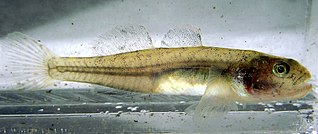
Eucyclogobius newberryi, the Northern tidewater goby, is a species of goby native to lagoons of streams, marshes, and creeks along the coast of California, United States. The Northern tidewater goby is one of six native goby species to California.

The sand goby, also known as a polewig or pollybait, is a species of ray-finned fish native to marine and brackish waters European waters from the Baltic Sea through the Mediterranean Sea and into the Black Sea where it occurs in sandy or muddy areas of inshore waters at depths of from 4 to 200 metres. This species can reach a length of 11 centimetres (4.3 in) TL. This species is sometimes kept in public aquariums. The sand goby is of a sandy colour, with darker markings on the sides and a creamy-white underside. In the breeding season the male fish has blue spot at the rear of the first dorsal fin, ringed with white. The fish has a slender body, and the head is about a quarter of the total length.
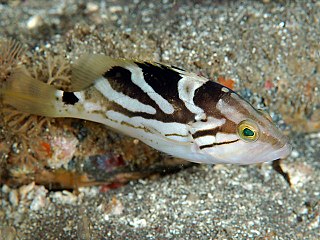
The comet grouper, also known as the comet cod or dot-dash grouper, is a species of marine ray-finned fish, a grouper from the subfamily Epinephelinae which is part of the family Serranidae, which also includes the anthias and sea basses. It is a species of deep coral reefs in the Indo-Pacific region.
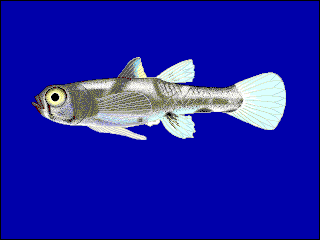
The dwarf pygmy goby or Philippine goby is a tropical species of fish in the subfamily Gobionellinae from brackish water and mangrove areas in Southeast Asia. It is one of the smallest fish species in the world. Males reach maturity at a standard length of 0.9 cm (0.35 in) and can reach up to 1.1 cm (0.43 in) in standard length, while the females can grow up to 1.5 centimetres (0.59 in) in total length. Adults weigh around 4 milligrams (0.00015 oz). It is known as bia and tabios in the Philippines.
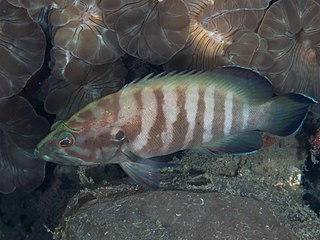
Cephalopholis boenak, the chocolate hind, brownbarred rockcod, brown-banded cod or brown-banded rockcod, is a species of marine ray-finned fish, a grouper from the subfamily Epinephelinae which is in the family Serranidae which also includes the anthias and sea basses. It is associated with reefs over a wide Indo-Pacific distribution. It is an important species for commercial fisheries in some parts of its range.

The channel darter is a species of freshwater ray-finned fish, a darter from the subfamily Etheostomatinae, part of the family Percidae, which also contains the perches, ruffes and pikeperches. It is native to North America where it typically occurs in the sandy or gravelly shallows of lakes and in small and medium-sized rivers in riffles over sand, gravel or rock bottoms. It is a small fish ranging from 34 to 72 mm in length, olive brown with darker speckles and sometimes with a dark spot below the eye and dark blotches along the flank. It feeds mostly on insect larvae and other small invertebrates and breeds in small streams. This species is listed as threatened by the Canadian Species at Risk Act (SARA) but overall it has a wide range and numerous sub-populations and the International Union for Conservation of Nature has rated it as a "least concern species".

The two-spotted goby is a species of goby native to marine and brackish waters of the eastern Atlantic Ocean where it can be found from the Faeroes and Norway to the northwestern coast of Spain. It has also been recorded from Estonia though records from the Mediterranean Sea are uncertain. They are common on all coasts of the United Kingdom. This species can reach a length of 6 centimetres (2.4 in) TL.

The common goby is a species of ray-finned fish native to fresh and brackish waters along the Atlantic and Baltic Sea coasts of Europe and northern Africa, with a range stretching from Norway to Morocco and Mauritania. It is also found in the Canary Islands. This species reaches a maximum length of 9 centimetres (3.5 in) TL.

Glossogobius giuris, the tank goby, is a species of goby native to fresh, marine and brackish waters from the Red Sea and East Africa through South Asia and the Indian Ocean to China, Australia and the islands of the Pacific Ocean. This species can also be found in the aquarium trade. It is also known as the bar-eyed goby, flat-headed goby and the Gangetic tank goby.
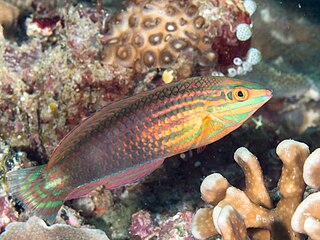
The red-lined wrasse, two-spotted wrasse or biocellated wrasse, Halichoeres biocellatus, is a species of wrasse native to shallow tropical waters in the western Pacific Ocean.

Valenciennea helsdingenii is a species of goby from the Indo-Pacific. It is commonly known as the twostripe goby, black-lined sleeper goby, or railway sleeper goby. It can grow up to a length of 25 cm (9.8 in) and is distinguishable by two prominent orange to black lines running longitudinally through its body.

The largetooth goby, also known as Wilbur's goby, is a species of ray-finned fish from the family Gobiidae which is native to the Indo-Pacific from the Seychelles to Micronesia. Its known range has been extended to the Red Sea as specimens were photographed at one site and collected at another site off Egypt. This species lives in sheltered marine waters at depths of from 0 to 20 metres preferring areas with sandy substrates. This species grows to a length of 6.5 centimetres (2.6 in) SL. This species is the only known member of its genus. This species is not obviously sexually dimorphic and it has a background colour of pale brown to greenish-brown and a pale ventral side. The body is marked with brown and white spots, pairs of larger brown spots create a mid-lateral row along its flanks and there is a dark spot on the caudal fin peduncle. It has a brown blotch on the cheek and a series of short brown bars along its back. The largetooth goby is a solitary fish which is found in coastal bays, lagoons and estuaries over fine sandy substrates close to the margins of reefs or silt beds in the vicinity of sheltered and often turbid coastal reefs. It is most frequently collected from shallow waters to 7 metres (23 ft), around coral reefs but off southern Japan, the largetooth goby occurs at the bottom of sandy bays. The specific name honours the American physician, Ray Lyman Wilbur (1875–1949) who was president of Stanford University from 1916–1943, as well as being the United States Secretary of the Interior from 1929–1933. Wilbur helped the author, Herre, get to Palau, the type locality of this species.

Psammogobius is a genus of fish in the family Gobiidae found in the Atlantic, Indian and Pacific Ocean.
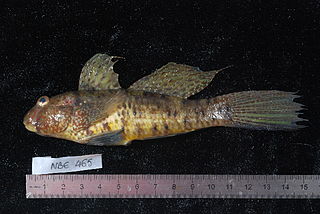
Amblygobius sphynx or the Sphinx goby is a species of goby found in brackish and salt water in the Indo-West Pacific region.

The masked grouper, also known as the thinspine grouper, rededged cod, red-edged grouper, slenderspine grouper, thinspine rockcod, white-margined grouper, white-square cod or white-square grouper, is a species of marine ray-finned fish, a grouper from the subfamily Epinephelinae which is part of the family Serranidae, which also includes the anthias and sea basses. It is found in the western Atlantic Ocean. It is the only species in the genus Gracila.

Chaenogobius annularis, the fork-tongued goby, is a species of goby from the subfamily Gobionellinae which is found in the brackish waters of temperate eastern Asia. It is the type species of the genus Chaenogobius.

Ctenogobiops tangaroai, the silver-spotted shrimp-goby, is a species of bony fish of the family Gobiidae, native to the reefs which is widespread in the Indo-West Pacific, from the Red Sea and Western Indian Ocean through northern Australia and Taiwan, southern Japan and Fiji. It occurs in fine-grained sand patches at depths of from 4 to 40 metres where it is commensal with alpheid shrimps, with a fish and shrimp sharing a burrow. This species can reach a length of 6 centimetres (2.4 in) TL. It can also be found in the aquarium trade. It is pale in colour marked with four rows of brown spots or dashes along its flanks, three diagonal rows of short, dark stripes on the posterior of its head with larger dark spots on the lower flanks which are frequently surrounded by smaller blue spots and there is a small white stripe above the pectoral fin base with a longer white streak on the pectoral fin. It is the type species of the genus Ctenogobiops.

Psammogobius pisinnus, the sandslope goby, is a species of goby in the family Gobiidae from Australia and New Guinea.
The Red Sea goby is a species of true goby from the family Gobiidae. It was once a species confined to the Red Sea but it has colonised the Suez Canal and the south-eastern Mediterranean by Lessepsian migration.

The squaretail mullet, also known as the diamondscale mullet, is a species of grey mullet from the family Mugilidae. It is an Indo-Pacific species and is the only species in the monospecific genus Ellochelon.




















